Cite this document
(“Word recognition/decoding skills, and prior knowledge are factors Essay”, n.d.)
Word recognition/decoding skills, and prior knowledge are factors Essay. Retrieved from https://studentshare.org/education/1637966-word-recognitiondecoding-skills-and-prior-knowledge-are-factors-which-affect-reading-proficiency-discuss-these-in-detail-and-critically-evaluate-the-ways-in-which-they-affect-the-literacy-development-of-eal-learners
Word recognition/decoding skills, and prior knowledge are factors Essay. Retrieved from https://studentshare.org/education/1637966-word-recognitiondecoding-skills-and-prior-knowledge-are-factors-which-affect-reading-proficiency-discuss-these-in-detail-and-critically-evaluate-the-ways-in-which-they-affect-the-literacy-development-of-eal-learners
(Word recognition/Decoding Skills, and Prior Knowledge Are Factors Essay)
Word recognition/Decoding Skills, and Prior Knowledge Are Factors Essay. https://studentshare.org/education/1637966-word-recognitiondecoding-skills-and-prior-knowledge-are-factors-which-affect-reading-proficiency-discuss-these-in-detail-and-critically-evaluate-the-ways-in-which-they-affect-the-literacy-development-of-eal-learners.
Word recognition/Decoding Skills, and Prior Knowledge Are Factors Essay. https://studentshare.org/education/1637966-word-recognitiondecoding-skills-and-prior-knowledge-are-factors-which-affect-reading-proficiency-discuss-these-in-detail-and-critically-evaluate-the-ways-in-which-they-affect-the-literacy-development-of-eal-learners.
“Word recognition/Decoding Skills, and Prior Knowledge Are Factors Essay”, n.d. https://studentshare.org/education/1637966-word-recognitiondecoding-skills-and-prior-knowledge-are-factors-which-affect-reading-proficiency-discuss-these-in-detail-and-critically-evaluate-the-ways-in-which-they-affect-the-literacy-development-of-eal-learners.


